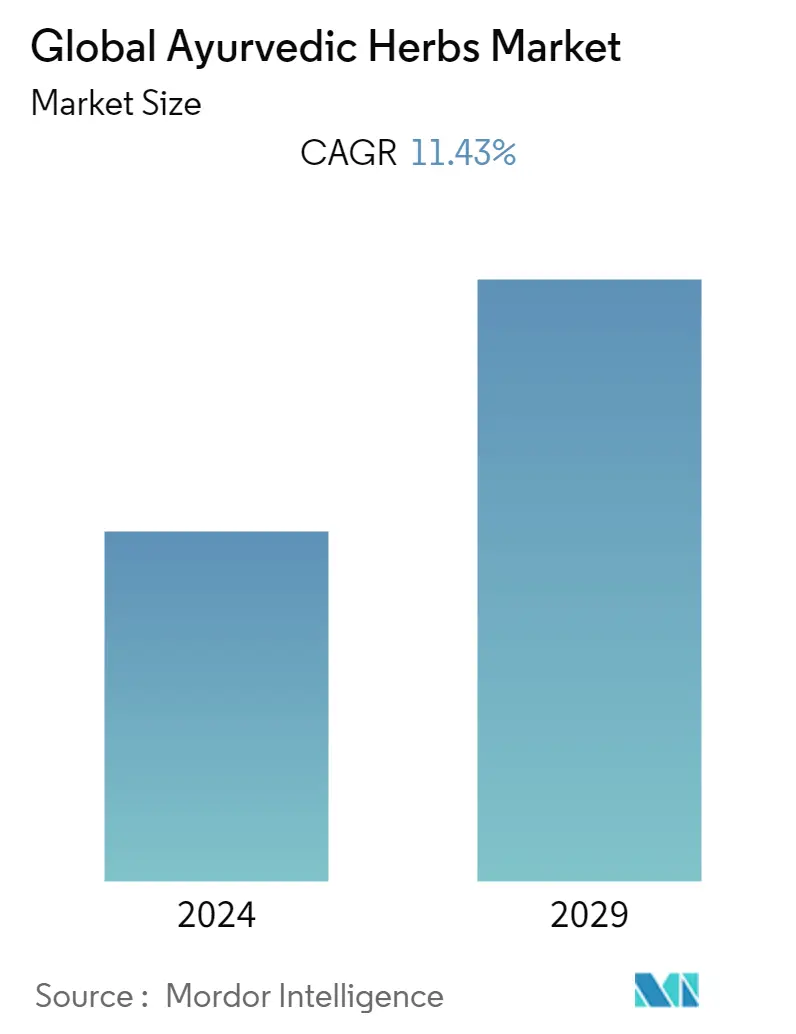Market Size of Global Ayurvedic Herbs Industry

| Study Period | 2019 - 2029 |
| Base Year For Estimation | 2023 |
| Forecast Data Period | 2024 - 2029 |
| CAGR | 11.43 % |
| Fastest Growing Market | Europe |
| Largest Market | Asia-Pacific |
Major Players
*Disclaimer: Major Players sorted in no particular order |
Ayurvedic Herbs Market Analysis
The ayurvedic herbs market is expected to register a CAGR of 11.43% during the forecast period (2022-2027).
Since the beginning of 2020, the Covid-19 pandemic have changed the healthcare system as well as affected the lifestyle of population worldwide. People were stuck indoors for months. During the isolation target population opt for home remedies and natural food supplement. This led people to follow a 5000-year-old history of Ayurveda. To boost immunity and find ways to live a healthy and safe lifestyle people opted for Ayurvedic treatments and remedies. This has impacted the studied market growth positively. The steps taken by governments have fueled the use of Ayurvedic herbs as preventive measure against Covid-19 infection driving the growth of the studied market. For instance, in October 2020, Ministry of AYUSH (Ayurveda, Yoga, Naturopathy, Unani, Siddha, and Homoeopathy), Government of India released the 'National Clinical Management Protocol based on Ayurveda and Yoga for the management of Covid-19'. In this protocol under the Ayurveda for management of Covid-19 section they have mentioned several use ways of using herbs to prevent the SARS-CoV2 infection. The above protocol suggested to gargle with warm water added with a pinch of turmeric and salt, or to gargle with water boiled with Triphala (dried fruits of Emblica oficinalis, Terminalia chebula,Terminalia bellerica) or Yashtimadhu (Glycyrrhiza glabra). The Nasal instillation of medicated oil (Anu taila or Shadbindu Taila) or plain oil (Sesame or Coconut) or nasal application of cow's ghee (Goghrita) once or twice in a day was suggested to prevent the Covid-19 infection.
Additionally, an article published in October 2020 titled 'A review on exploring the siddha and ayurvedic medicines for covid-19 infection' mentioned that Covid19 has occurred in different types like mild respiratory illness (nose, throat, and lungs), severe acute respiratory syndrome (SARS), and Middle East respiratory syndrome (MERS) and several studies have been done on curative effects of Ayurvedic and other traditional medicines on these various diseases. This above-mentioned article concluded that, Siddha and Ayurvedic medicines have mitigated COVID-19 infections in many cases. Hence, owing to the above-mentioned factors and research, the demand for ayurvedic herbs have increased, driving the growth of the studied market during the Covid-19 pandemic.
Furthermore, factors such as rising burden of chronic diseases globally, and awareness on the side-effects of other medicines is further driving the consumer preference for ayurvedic products, benefiting the studied market. Increasing popularity of natural and organic medicines and their benefits among the consumers also act as a driving factor for the growth of the studied market.
There is an increasing popularity and surging demand of ayurvedic products for several other applications including skin care, hair care, oral care among consumers. Along with government initiatives, this surging demand is driving an increasing number of market players to innovate and develop new products. Hence, boost the growth of the studied market. For instance, in May 2021, Ministry of AYUSH (Ayurveda, Yoga, Naturopathy, Unani, Siddha, and Homoeopathy), India has launched a massive nationwide campaign to distribute its polyherbal ayurvedic drugs AYUSH 64 and Sidha drug Kabasura Kudineer for COVID-19 patients that have not been hospitalized. The efficacy of these two drugs has been proven through strong multi-center clinical trials says the Ministry of AYUSH (Ayurveda, Yoga, Naturopathy, Unani, Siddha, and Homoeopathy).
In addition, Dabur India Ltd. entered the Health Food Drink category with the launch of 'Dabur Vita' in December 2021. Dabur Vita is made with a unique blend of more than 30 herbs such as Ashwagandha, Giloy and Brahmi, which are scientifically proven to provide better immunity as well as to promote physical and mental growth among kids.
Furthermore, an article published in July 2021 titled 'Ayurveda recognized as a system of medicine in 16 countries', by Organiser.org shows that, Ayurveda is recognized as a System of Medicine in Nepal, Sri Lanka, Pakistan, Bangladesh, United Arab Emirates (UAE), Oman, Saudi Arabia, Bahrain, Malaysia, Mauritius, Hungary, Serbia, Tanzania, Switzerland, Cuba, and Brazil. While Romania, Hungary, Latvia, Serbia, and Slovenia are five countries of the European Union (EU), where Ayurvedic practices is regulated. Similarly, several other countries have also incorporated Ayurvedic herbs as systems. According to the similar source, AYUSH (Ayurveda, Yoga, Naturopathy, Unani, Siddha, and Homoeopathy) products are exported to more than 100 foreign countries either as Medicine or as Food supplements.
Therefore, owing to the aforesaid factors the global ayurvedic herbs market is gaining demand globally and is expected to grow over the forecast period.
Ayurvedic Herbs Industry Segmentation
As per the scope of the report, Ayurveda is an ancient Indian healing system that is focused on balancing the mind and spirit, cleansing the body, and defending against disease. Rather than responding to disease, ayurvedic medicine or herbs aims to prevent illness. The practitioners use ayurvedic herbs as a holistic approach to health including Nutrition, Yoga, Aromatherapy, Meditation, Therapeutic oils, Skincare products, and others.
The ayurvedic herbs market is segmented by Product Type (Healthcare Products and Personal Products), Application (Skin Diseases, Respiratory Disorders, Autoimmune Diseases, Cancer Treatment, Cardiovascular Diseases, and Other Applications), Distribution Channel (Retail Pharmacy, E-Pharmacy, and Other Distribution Channels) and Geography (North America, Europe, Asia-Pacific, Middle East & Africa, and South America). The report offers the value (in USD million) for the above segments.
| By Product Type | |||||
| |||||
|
| By Application | |
| Skin Diseases | |
| Respiratory Disorders | |
| Autoimmune Diseases | |
| Cancer Treatment | |
| Cardiovascular Diseases | |
| Other Applications |
| By Distribution Channel | |
| Retail Pharmacy | |
| E-Pharmacy | |
| Other Distribution Channel |
| Geography | |
| North America | |
| Europe | |
| Asia-Pacific | |
| Middle East and Africa | |
| South America |
Global Ayurvedic Herbs Market Size Summary
The ayurvedic herbs market is experiencing significant growth, driven by a resurgence in interest towards natural and organic products, particularly following the Covid-19 pandemic. The pandemic prompted a shift in consumer behavior, with many individuals turning to Ayurvedic remedies to boost immunity and maintain health, as evidenced by government endorsements and protocols promoting Ayurvedic practices. This trend has been further supported by increasing awareness of the side effects associated with conventional medicines and a growing preference for natural alternatives. The market is also benefiting from the rising burden of chronic diseases globally, which has led to a heightened demand for Ayurvedic products across various applications, including skincare, hair care, and oral care. The expansion of product offerings by market players, such as Dabur India Ltd.'s entry into the Health Food Drink category, underscores the growing consumer interest in Ayurvedic solutions.
The Asia Pacific region is poised to dominate the ayurvedic herbs market, fueled by increasing consumer awareness and per capita expenditure on natural products. Government initiatives in countries like India, which promote Ayurvedic products and support traditional medicine systems, are playing a crucial role in this growth. The market is characterized by a competitive landscape with both local and global players actively launching new products and forming strategic collaborations. Notable companies such as Dabur India Ltd., Colgate-Palmolive Company, and Procter & Gamble are leading the charge in innovation and market expansion. The global recognition of Ayurveda as a system of medicine in several countries further bolsters the market's growth prospects, as does the ongoing demand for Ayurvedic products in regions beyond Asia.
Global Ayurvedic Herbs Market Size - Table of Contents
-
1. MARKET DYNAMICS
-
1.1 Market Overview
-
1.2 Market Drivers
-
1.2.1 Rise in Awareness for Alternative Medicine and Health Consciousness among Consumers
-
1.2.2 Growing Demand for Natural and Organic Products and Improved Distribution Channel
-
-
1.3 Market Restraints
-
1.3.1 Lack of Interest in the Ayurvedic Industry
-
1.3.2 Less Research and Development for High Yielding Varieties
-
-
1.4 Porter's Five Force Analysis
-
1.4.1 Threat of New Entrants
-
1.4.2 Bargaining Power of Buyers/Consumers
-
1.4.3 Bargaining Power of Suppliers
-
1.4.4 Threat of Substitute Products
-
1.4.5 Intensity of Competitive Rivalry
-
-
-
2. MARKET SEGMENTATION (Market Size by Value - USD million)
-
2.1 By Product Type
-
2.1.1 Healthcare Products
-
2.1.1.1 Ayurvedic Nutraceuticals
-
2.1.1.2 Ayurvedic Medicines
-
2.1.1.3 Dietary Supplements
-
-
2.1.2 Personal Products
-
2.1.2.1 Oral Care
-
2.1.2.2 Hair Care and Fragrances
-
2.1.2.3 Skin care and Cosmetics
-
-
-
2.2 By Application
-
2.2.1 Skin Diseases
-
2.2.2 Respiratory Disorders
-
2.2.3 Autoimmune Diseases
-
2.2.4 Cancer Treatment
-
2.2.5 Cardiovascular Diseases
-
2.2.6 Other Applications
-
-
2.3 By Distribution Channel
-
2.3.1 Retail Pharmacy
-
2.3.2 E-Pharmacy
-
2.3.3 Other Distribution Channel
-
-
2.4 Geography
-
2.4.1 North America
-
2.4.2 Europe
-
2.4.3 Asia-Pacific
-
2.4.4 Middle East and Africa
-
2.4.5 South America
-
-
Global Ayurvedic Herbs Market Size FAQs
What is the current Global Ayurvedic Herbs Market size?
The Global Ayurvedic Herbs Market is projected to register a CAGR of 11.43% during the forecast period (2024-2029)
Who are the key players in Global Ayurvedic Herbs Market?
Procter & Gamble (P&G), Unilever, Emami Limited, Himalaya Wellness Company and Dabur India Limited are the major companies operating in the Global Ayurvedic Herbs Market.

